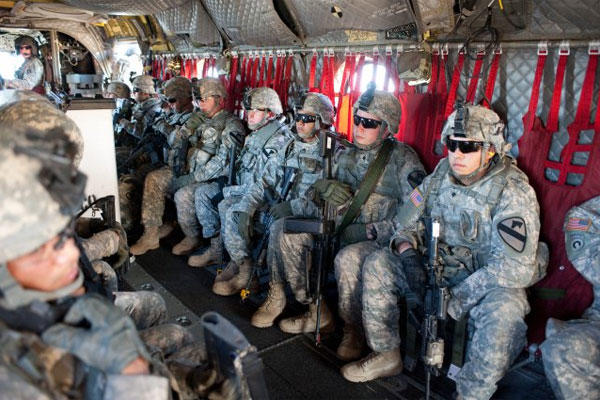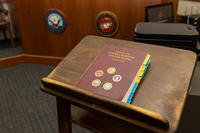FORT HOOD, Texas -- The California Army National Guard's Company B, 1st Battalion, 126th Aviation Regiment, one of the oldest Chinook helicopter units in the Army, is no stranger to Afghanistan.
The unit deployed to Regional Command-East five years ago, and all of the unit's pilots-in-command and flight engineers, or PCs and FEs, either were on that deployment or had previously deployed to Afghanistan while on active duty.
Although the unit from Stockton, Calif., has ample experience with Afghanistan, they recently mobilized to Fort Hood for the first time.
"It's a lot different to deploy in the Guard than in active duty," said the Schooner's tactical operations officer, Chief Warrant Officer 3 Lucas Eggers.
Before mobilizing at Fort Hood to be trained by Division West's 166th Aviation Brigade, known as "the Schooners," conducted three two-week training exercises focusing on pre-deployment training tasks at Camp Roberts in their home state of California. This enabled them to focus specifically on flight training once in Texas. In fact, the group amassed more than 400 flight hours, including more than 150 hours of night flying, at Fort Hood.
Much of the Schooner's flight preparations focused on both individual as well as collective flight training, particularly air assault missions. The focus on individual training was the result of two of their senior flight engineers, including their first sergeant, being unable to deploy because of medical reasons in the week prior to mobilization.
Despite the challenges, the Schooners rose to the occasion and quickly advanced several members of the team to fill out 12 fully mission-qualified crews.
First Sgt. Jeff Stanfield, who met the unit at Fort Hood one week after the rest of the unit, was glad to have the opportunity to assist the group.
"Luckily, I'm already part of the family," Stanfield said.
After several days of initial in-processing and deployment readiness activities, the Schooners began their flight training with local area orientations and then began individual readiness level progression training, maximizing their training by supporting III Corps units. In particular, the 166th Aviation Brigade arranged for them to support the 85th Civil Affairs Brigade, a civil affairs battalion that was conducting a deployment readiness certification, and two companies from 1st Battalion, 8th Cavalry, 2nd Brigade Combat Team, 1st Cavalry Division, that were conducting company-level collective training in preparation for a deployment scheduled for next summer.
"The (Company B, 1st Battalion, 8th Cavalry, 2nd Brigade Combat Team, 1st Cavalry Division) mission was basically the typical mission set that we're going to be doing once we're overseas," said 1st Lt. Chase Ross, a Schooners platoon leader. "We'll pick them up and then we'll drop them on another target. We're practicing time-on-target, navigation, and talking on the radios."
The Schooners also supported the 120th Infantry Brigade's training of another deploying expeditionary force unit by conducting casualty evacuation operations, enabling Soldiers in the Army Reserve's 993rd Transportation Company to practice calling in medical evacuation requests and communicating with aircraft. This simultaneously enabled the Schooners to familiarize themselves with the special requirements involved with a Chinook helicopter casualty evacuation. The Schooners benefitted from this practice, since they were called on to evacuate the wounded from the Battle of Wanat in July of 2008 and know the complexity and importance of such a mission.
After completing aerial gunnery with their newest crew members, the Schooners deployed seven of their aircraft to Double Eagle II Airport in New Mexico for a week of intensive flight training in the mountains. There, the Schooners focused first on dust landing techniques, honing the critical crew coordination and flight skills necessary to land in the sand and dust of Afghanistan. Their main objective was to develop their younger pilots-in-command.
"I want all of my PCs and FEs to be 100 percent comfortable conducting zero illumination dust landings," said Capt. Ben Bowman, commander of Company B, 1st Battalion, 126th Aviation Regiment. Upon completion of their dust landings, the Schooners moved on to high altitude landing zones, practicing power management techniques and pinnacle landings that will be useful for operations in the mountains of Afghanistan.
Once they recovered their aircraft at Fort Hood, which included reacting to a precautionary landing near Coleman Airfield in west Texas, the Schooners then turned their attention to getting their aircraft ready for the culminating training exercise, or CTE, conducted by the 166th Aviation Brigade.
Aircrews focused on air assault mission planning, receiving and planning two air assault missions during their company collective training. That practice paid off during the CTE, when the unit received five air assault missions over the course of five days, on top of air mission requests for numerous air movement operations.
The Schooners continued their support of 1st Battalion, 8th Cavalry, 2nd Brigade Combat Team, 1st Cavalry Division, conducting internal and external load training with the forward support company. They again supported the 120th Infantry Brigade, conducting an insertion and extraction for a key leader engagement conducted by the Iowa Army National Guard's 1034th Combat Sustainment Support Battalion.
"This gets me a little bit more oriented," said Spc. Jesus Camacho, a crew chief with Company B, 1st Battalion, 126th Aviation Regiment. "I'm getting used to people jumping on and off the aircraft, what to be aware of, what they might do, what they might not do, how to talk to them. It's a lot different from not having any passengers on the aircraft. It's good training, overall. I feel like I've learned a lot."
Upon completion of their CTE, the Schooners staged their deploying aircraft at Robert Gray Army Airfield, transferred their remaining aircraft to other National Guard units and began packing their equipment. Confident in their training and readiness, the Schooners are prepared for their mission in RC-East.
When asked about the value of the two-month training experience at Fort Hood, 1st Lt. Perkins said, "Fort Hood makes you ready to go to Afghanistan."






















